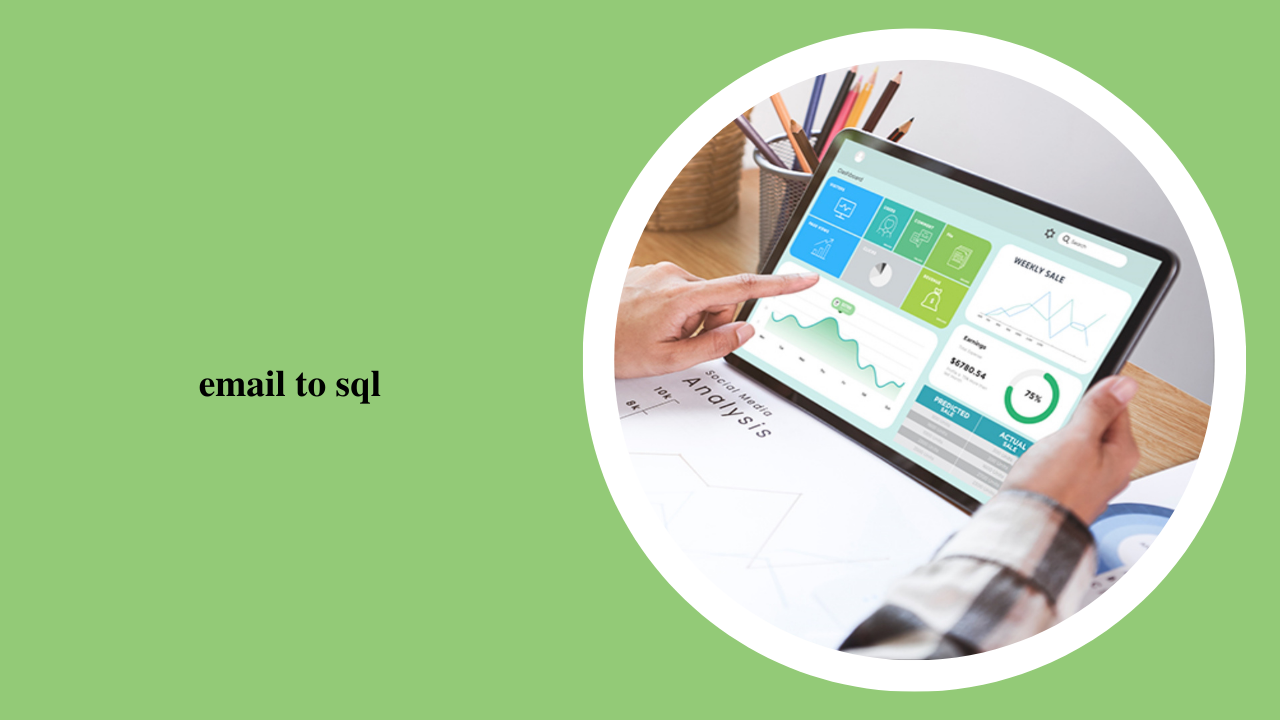- Home
- MEMBERs Forum
- Turning Emails into Databases: Understanding Email to SQL
Turning Emails into Databases: Understanding Email to SQL
In today's digital world, we get many emails every day. These emails often contain important information. This information could be about customers, sales, or projects. Sometimes, we need to take this information and put it into a database. A database helps us organize and analyze the data. SQL is a special language used to manage databases. So, "email to SQL" means taking information from emails and putting it into a database using SQL. This can help businesses work smarter and make better decisions. It saves time and reduces mistakes compared to manually entering data.
Why Convert Emails to SQL Databases?
There are several good reasons to convert email data into SQL databases. First, it helps in organizing large amounts of information. Imagine having thousands of emails with customer orders. It would be hard to find specific orders quickly. However, if this data is in a SQL database, you can easily search and filter it. Second, it allows for better analysis of data. With email data in a database, you can use SQL queries to find trends and patterns. For example, you could find out which products are ordered most frequently. Third, it improves efficiency. Instead of manually copying data from emails, automated tools can do this job much faster. Furthermore, it reduces the risk of human errors that can happen during manual data entry. Finally, it helps in integrating email data with other business systems. For instance, you can connect your customer relationship management (CRM) system with the email database.
Understanding the Process
The process of converting emails to SQL generally involves a few key steps. First, the emails need to be accessed and extracted. This can be done using special software or scripts that can connect to your email server or read email files. Next, the important information needs to be identified and parsed from the email content. This can be tricky because emails can have different formats. However, tools can be trained to recognize specific types of data, like order details or customer information. After that, the extracted data needs to be transformed into a format that can be stored in a SQL database. This might involve cleaning the data and organizing it into tables and columns. Finally, the data is loaded into the SQL database. Once the data is in the database, you can use SQL queries to manage and analyze it.
Methods and Tools for Email to SQL Conversion
Several methods and tools can help with the email to SQL conversion. One common method is using custom scripts written in programming languages like Python. These scripts can be designed to connect to email accounts, read emails, extract specific data using regular expressions or natural language processing (NLP) techniques, and then insert this data into a SQL database. Another approach involves using specialized email parsing software. These tools often come with pre-built templates for common email formats and can automate the data extraction and transformation process. Furthermore, some business intelligence (BI) and data ivory coast whatsapp lead integration platforms offer connectors that can link to email systems and SQL databases, allowing for automated data pipelines. Moreover, cloud-based services are available that provide email parsing and data integration capabilities without the need for managing software infrastructure. Consequently, businesses can choose the method that best suits their technical skills and specific needs.
Challenges in Email to SQL Conversion
While converting emails to SQL offers many benefits, there are also some challenges to consider. One major challenge is the variability in email formats. Emails can look very different depending on who sent them and what they are about. This makes it hard to create a universal solution for data extraction. Additionally, dealing with unstructured data within emails can be complex. Unlike structured data in forms or spreadsheets, email content is often free-form text. Moreover, handling attachments can add another layer of difficulty. Important data might be contained in PDF files or other document formats attached to emails. Furthermore, ensuring data accuracy during the conversion process is crucial. Errors in extraction or transformation can lead to incorrect data in the database. Therefore, careful planning and robust error handling mechanisms are necessary.

Best Practices for Efficient Email to SQL Integration
To ensure a smooth and efficient email to SQL integration, it's important to follow some best practices. First, clearly define the data you need to extract from your emails. Identify the specific information that is important for your analysis and database. Second, choose the right tools and methods based on your technical expertise and the complexity of your email data. Consider whether custom scripting, off-the-shelf software, or cloud services would be the best fit. Third, implement robust error handling and data validation processes. This will help ensure the accuracy and reliability of the data in your SQL database. Fourth, regularly monitor the integration process to identify and address any issues that may arise. Fifth, if possible, standardize the format of your important emails. This can significantly simplify the data extraction process. Finally, consider using machine learning and NLP techniques for more accurate extraction of unstructured data. By following these practices, you can effectively turn your emails into valuable database information.
Why Convert Emails to SQL Databases?
There are several good reasons to convert email data into SQL databases. First, it helps in organizing large amounts of information. Imagine having thousands of emails with customer orders. It would be hard to find specific orders quickly. However, if this data is in a SQL database, you can easily search and filter it. Second, it allows for better analysis of data. With email data in a database, you can use SQL queries to find trends and patterns. For example, you could find out which products are ordered most frequently. Third, it improves efficiency. Instead of manually copying data from emails, automated tools can do this job much faster. Furthermore, it reduces the risk of human errors that can happen during manual data entry. Finally, it helps in integrating email data with other business systems. For instance, you can connect your customer relationship management (CRM) system with the email database.
Understanding the Process
The process of converting emails to SQL generally involves a few key steps. First, the emails need to be accessed and extracted. This can be done using special software or scripts that can connect to your email server or read email files. Next, the important information needs to be identified and parsed from the email content. This can be tricky because emails can have different formats. However, tools can be trained to recognize specific types of data, like order details or customer information. After that, the extracted data needs to be transformed into a format that can be stored in a SQL database. This might involve cleaning the data and organizing it into tables and columns. Finally, the data is loaded into the SQL database. Once the data is in the database, you can use SQL queries to manage and analyze it.
Methods and Tools for Email to SQL Conversion
Several methods and tools can help with the email to SQL conversion. One common method is using custom scripts written in programming languages like Python. These scripts can be designed to connect to email accounts, read emails, extract specific data using regular expressions or natural language processing (NLP) techniques, and then insert this data into a SQL database. Another approach involves using specialized email parsing software. These tools often come with pre-built templates for common email formats and can automate the data extraction and transformation process. Furthermore, some business intelligence (BI) and data ivory coast whatsapp lead integration platforms offer connectors that can link to email systems and SQL databases, allowing for automated data pipelines. Moreover, cloud-based services are available that provide email parsing and data integration capabilities without the need for managing software infrastructure. Consequently, businesses can choose the method that best suits their technical skills and specific needs.
Challenges in Email to SQL Conversion
While converting emails to SQL offers many benefits, there are also some challenges to consider. One major challenge is the variability in email formats. Emails can look very different depending on who sent them and what they are about. This makes it hard to create a universal solution for data extraction. Additionally, dealing with unstructured data within emails can be complex. Unlike structured data in forms or spreadsheets, email content is often free-form text. Moreover, handling attachments can add another layer of difficulty. Important data might be contained in PDF files or other document formats attached to emails. Furthermore, ensuring data accuracy during the conversion process is crucial. Errors in extraction or transformation can lead to incorrect data in the database. Therefore, careful planning and robust error handling mechanisms are necessary.

Best Practices for Efficient Email to SQL Integration
To ensure a smooth and efficient email to SQL integration, it's important to follow some best practices. First, clearly define the data you need to extract from your emails. Identify the specific information that is important for your analysis and database. Second, choose the right tools and methods based on your technical expertise and the complexity of your email data. Consider whether custom scripting, off-the-shelf software, or cloud services would be the best fit. Third, implement robust error handling and data validation processes. This will help ensure the accuracy and reliability of the data in your SQL database. Fourth, regularly monitor the integration process to identify and address any issues that may arise. Fifth, if possible, standardize the format of your important emails. This can significantly simplify the data extraction process. Finally, consider using machine learning and NLP techniques for more accurate extraction of unstructured data. By following these practices, you can effectively turn your emails into valuable database information.


